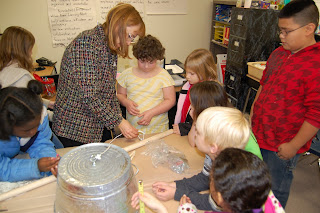How To Make A Panpipe
- Cut three or four straws so that you have five pieces varying in length. These are your playing straws.
- Roll your modeling clay into pea-sized balls (slightly larger than the opening of the straws). Plug the bottom of each straw and be sure that it is completely plugged. You can check by holding the open end of the straw up to your eye and look for light coming through. If you see light you haven't sealed it well enough.
- Arrange the playing straws in order of length with the shortest straw at one end and the longest at the other end. Be sure that all the clay plugs are on the bottom and the open ends on the top. Also, make sure they are level across the top.
- Cut four two inch pieces of straw for spacers. Place a two-inch spacer straw between each of the six playing straws. Line the spacer straws up 1/4 inch lower than the six pieces varying in length.
- Place a strip of tape around all of the straws even with one end of the spacer straws. Place another strip of tap around all of the straws even with the other end of the spacer straws.
- Decorate your panpipe and put your name on it.
How Does The Panpipe Work?
When you blow across the top of the panpipe, it makes the air inside the straw vibrate. Small air spaces vibrate more rapidly than large air spaces. When there is very little air in the panpipe, you produce a high note. When there is more air, the note is lower.
Tips On Playing Your Panpipe
Hold your panpipe upright witht eh open end of the plastic air column on your lower lip. Extend your upper lip and blow gently across the top of the straws. If you blow too hard you can begin to feel a little dizzy. Warning: If you EVER feel dizzy while trying to play your baster stop immediately, and take a break.
If You Still Can't Get Sound
- If your clay has not sealed the bottom fully you will not be able to get sound. Try holding your finger or thumb over the bottom opening where you have the clay and blow gently. Be sure that you are covering the entire hole!
- Practice blowing across the top of a bottle until you get sound. Once you master playing a bottle, try you panpipe again.
- You can also fold the bottom of the straw up and tape each end to close the bottom end.
*This information was provided by Rachel Sumner























































